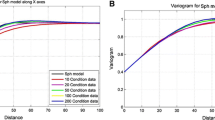Abstract
The usual paradigm in the application of geostatistical simulation has been to use a variogram model and a simulation algorithm to generate multiple realizations (conditional or non-conditional) of the random function model. In general the variogram model is inferred from the experimental data and then it has an uncertainty which can be large if the number of experimental data is small. However, this variogram uncertainty has usually been ignored, with the consequence that the simulated fields could be reproducing a spatial variability that does not mimic the underlying variability. Certainly there is an amount of variability in the local variogram of each simulated realization because of the ergodic fluctuations of the simulation algorithm that has been used. But we show in this paper that when the number of experimental data is small (which is not unusual in some disciplines of geosciences, such as groundwater hydrology or petroleum engineering) the description of the true underlying variability of the spatial variable may not be covered by the ergodic fluctuations of the random field realizations. Thus a change of paradigm is required. In the new paradigm, the uncertainty of the variogram parameters is taken into account and propagated into the simulations in a statistical way in order to cover up the underlaying variability. This alternative paradigm does not require new simulation algorithms; rather, it calls for choosing more carefully the range of variogram models (in opposition to using only the estimated model) that will be injected into the simulation algorithm. An example illustrates how the application of this approach is straightforward and can be important in reliability studies where geostatistical simulation is used to model the spatial uncertainty of a regionalized variable between the experimental locations.













Similar content being viewed by others
References
Borgman L, Taheri M, Hagan R (1984) Three-dimensional frequency-domain simulations of geological variables. In: Verly G et al. (eds) Geostatistics for natural resources characterization. Reidel, Dordrecht, Holland, pp 517–541
Chilès J-P, Delfiner P (1999) Geostatistics: modelling spatial uncertainty. Wiley, New York
Christakos G (1992) Random field models in the earth sciences. Academic Press, San Diego, CA
Cressie N (1991) Statistics for spatial data. Wiley, New York
Deutsch CV, Journel AG (1998) GSLIB: Geostatistical software library and user’s guide, 2nd edn. Oxford University Press, New York, 369 p
Goovaerts P (1997) Geostatistics for natural resources evaluation. Oxford University Press, New York
Gotway C (1992) The use of contitional simulation in nuclear-waste-site performance assessment. Technometrics 36(2):129–141
Gotway C, Rutherford BM (1994) Stochastic simulation for imaging spatial uncertainty: comparison and evaluation of available algorithms. In: Amstrong M, Dowd PA (eds) Geostatistical simulations, pp 1–21. Kluwer Academic Publishers, 255 p
Gutjahr A (1989) Fast Fourier transforms of random fields. Technical Report No. 4-R58–2690R, Los Alamos, New Mexico
Hartley HO, Rao JNK (1967) Maximum likelihood estimation for the mixed analysis of variance model. Biometrika 54(1–2):93–108
Hoeksema RJ, Kitanidis PK (1985) Analysis of the spatial structure of properties of selected aquifers. Water Resour Res 21:563–572
Isaaks EH, Srisvastava RM (1989) Applied geostatistics. Oxford University Press, Oxford, UK
Journel AG, Huijbregts Ch J (1978) Mining geostatistics. Academic Press, New York
Journel AG (1989) Fundamentals of geostatistics in five lessons. American Geophysical Union, Washington, DC
Kalbfleisch JG (1979) Probability and statistical inference II. Springer, New York, 316 p
Kitanidis PK (1987) Parametric estimation of covariances of regionalized variables. Water Resour Bull 23:557–567
Marchant BP, Lark RM (2004) Estimating variogram uncertainty. Math Geol 36(8):867–898
Mardia KV, Marshall RJ (1984) Maximum likelihood estimation of models for residual covariance in spatial regression. Biometrika 71(1):135–146
McGullagh P, Nelder JA (1989) Generalized linear models, 2nd edn. Chapmand and Hall, Cambridge, 511 p
Pardo-Iguzquiza E (1997) MLREML: a computer program for the inference of spatial covariance parameters by maximum likelihood and restricted maximum likelihood. Comput. Geosci. 23(2):153–162
Acknowledgments
The first author is a “Ramon y Cajal” Grant Holder from the Ministry of Science and Education of Spain. We are grateful for the financial support given by the Spanish MCyT (Project CLS2006-06845/CLI) and Junta de Andalucía (Group RNM122). We would like to thank the reviewers by their constructive criticism.
Author information
Authors and Affiliations
Corresponding author
Rights and permissions
About this article
Cite this article
Pardo-Iguzquiza, E., Chica-Olmo, M. Geostatistical simulation when the number of experimental data is small: an alternative paradigm. Stoch Environ Res Risk Assess 22, 325–337 (2008). https://doi.org/10.1007/s00477-007-0118-1
Published:
Issue Date:
DOI: https://doi.org/10.1007/s00477-007-0118-1




